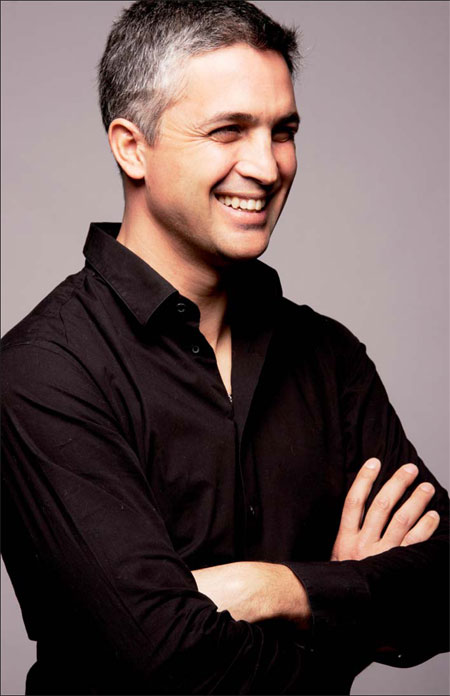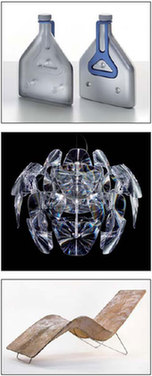Designs for life
Updated: 2012-11-30 09:59
By Chen Yingqun (China Daily)
|
|||||||||||
|
Francisco Gomez Paz says that beauty comes from making good decisions. Photos Provided to China Daily |
|
From top: The award-winning Solar Bottles, the Hope Chandelier and Apero chaise longue, all designed by Paz. |
For industrial designer Francisco Gomez Paz, curiosity, a model engine and a box of toys sparked a lifelong passion to create something new and functional
It's not unusual for children to take apart their toys. Exploring how things work and what they're made of is all part of growing up. But for Francisco Gomez Paz, it became a career. The 37-year-old Milan-based industrial designer is at the top of his profession, driven by a desire to always create something new - and it all began as a child.
One day, as Paz was playing with his toys, he found a small motor that belonged to his father and curiosity drove him to see if he could combine the two.
"Curiosity is the strongest tool that I have in my life to understand the world," he says.
He took the toy apart and reassembled it with the engine to make the toy move.
"When I saw the toy moving I felt something amazing inside of me. I felt an ability to create something that I had imagined. I get the same feeling now when I work on a design. It's the feeling that makes me want to keep progressing," he says.
Paz's father played a strong part in nurturing his career choice, and not just by leaving the mini engine around for him to play with. He is an architect, and the young Paz grew up around design and creativity.
Paz was born in Salta, Argentina and obtained a degree in industrial design at the National University of Cordoba. In 1998 he moved to Milan where he started his own design office in 2004.
He went on to win a number of awards, including the Good Design Award 2010, the Red Dot Award 2010 and the Prize of Prizes for Innovation in Design in 2011, presented to him by Italian President Giorgio Napolitano.
This month Paz brought his creative flair to Beijing for the Get It Louder exhibition, which acts as a showcase for global designers. Two of his works were on show: the Hope Chandelier, a modernist take on the traditional crystal chandelier, designed by Paz and Paolo Rizzatto; and the Solar Bottle, a container that disinfects water using solar power, designed by Paz and Alberto Meda.
Zang Feng, curator of the future section of the exhibition, where Paz's work was on display, invited him because of his talent for being ahead of the trend.
"Francisco's work is both beautiful and functional. We want more Chinese to see what good design should be like. His use of materials, handling of cultural elements and other skills are worth learning," he says.
Aside from the exhibition, Paz also gave a two-hour talk about his work.
"It's an opportunity to spread a way of thinking, and if that generates opportunities with other people or companies that think the same way, it's good," he says.
Architect Liu Yang, 30, who visited the exhibition, praised Paz for finding a different take on everyday objects. "His designs surpass the conventional views of products and are very refreshing," he says.
Paz strives to bring something new to each design, even if only a small element, in order to push forward boundaries.
"I don't like to repeat things, or to just redo things with a small difference in shape. I think as designers we have a responsibility to do more than that. It's difficult, though," he says.
The hardest part of his job is convincing clients who often come to him with old designs and ask him to make something similar. Bringing new ideas to a project and overcoming other people's doubts about them can be a struggle.
"To create a successful product, all the parts of a company need to believe the same thing, and to push a lot of boundaries regarding what is possible," he says.
"You need to have trust, and often to build this trust takes time. Over time you start to develop a relationship, you start to speak the same language and you start to believe and think in the same way.
"If they don't believe that my ideas will work, I just create one and show it to them. I always do things; I don't leave problems to others. I just solve problems and never say that things are not possible."
Paz's thought process can encompass a whole range of ideas about technology, the user, the company, the brand, problems to be solved, and daily life.
The most interesting part of the job is learning, he says. Being an industrial designer requires curiosity and a willingness to learn, but with this comes a gradual accumulation of knowledge.
"Each project helps you to learn many things. If you are making a bicycle, you learn how to ride one, what people like about bicycles, you learn about wheels," he says.
Marketing professional Wu Xiao says he appreciates the human touch and open thinking of Paz's designs.
"He has brought us some new ideas about design and broadened our horizons," Wu says.
Paz tries to incorporate social meaning into his work. For him, his two most important pieces of design have been Apero and Solar Bottle.
Apero is a chaise longue entirely handmade in Argentina, which Paz hopes will help people discover the craftsmanship of northern Argentina. Solar Bottle could have considerable use in regions where polluted water is a problem.
"These two projects, in my opinion, show the direction that designers need to look in," he says.
"With these kinds of projects there is a big social effect."
According to Zang Feng, many Chinese designers focus on the look of a product and symbolic meaning above functionality.
For Paz, functionality should not be separated from appearance as the real beauty of an object comes from its usefulness.
"When you start to do something, if you start from an idea, the shape is not the idea, it's how you use it, and everything goes from that. So, you have an idea and slowly work out everything from that," he says.
"Beauty is something that comes from making good decisions in the process of making a product."
chenyingqun@chinadaily.com.cn
(China Daily 11/30/2012 page28)
Today's Top News
Rescuers race against time for quake victims
Telecom workers restore links
Coal mine blast kills 18 in Jilin
Intl scholarship puts China on the map
More bird flu patients discharged
Gold loses sheen, but still a safe bet
US 'turns blind eye to human rights'
Telecom workers restore links
Hot Topics
Lunar probe , China growth forecasts, Emission rules get tougher, China seen through 'colored lens', International board,
Editor's Picks

|

|

|

|

|

|







